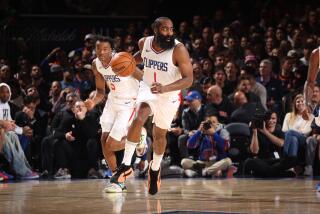Inventor Counts His Success on Fingers and Toes
- Share via
The learning curve has been long and steep, but after a decade and more than $50,000, amateur inventor Kirk Langman thinks success may be at hand.
He just wishes he’d figured out sooner that simple is better--and usually cheaper.
Langman, 40, thought he had a sure-fire hit in 1989 when he and some friends dreamed up a compact disc player that could store dozens of disks. He got a patent, a prototype and lost $45,000 trying to turn his dream into reality--money the onetime chiropractor borrowed from his family. Despite a couple of nibbles from IBM Corp. and Sun Microsystems Inc., the machine was just too complicated to work reliably, and other CD mega-changers were starting to hit the market.
Lesson learned, he came up with his next invention: a combination fingernail and toenail clipper. One end cuts toenails, the other, fingernails. Total cost to perfect: $7,000.
“I came to the conclusion, why not simplify the whole process?” said Langman, who is in licensing talks with three companies interested in his clippers.
Unlike their counterparts at universities or in corporate America, individual inventors often lack the money, knowledge and support needed to get their inventions to market. Although the U.S. Patent and Trademark Office gives individuals such as Langman a half-off price break on the standard $4,000 patent application fee, independent inventors submit just 14% of the applications received in an average year.
Some of the lucky ones, though, will earn a share of the roughly $2 billion a year generated by patent licensing, according to the intellectual-property specialists at law firm Pillsbury Madison & Sutro in Los Angeles.
Langman is optimistic he’ll be signing a deal soon with one of the manufacturers he dug up by calling a nearby drugstore to ask about their clipper vendors. He got the names of 12 companies, then sent them letters, photos of his clippers and copies of his Patent No. 5,806,186.
*
His homespun research may make licensing executives cringe, but the positive reaction he has received so far is unusual, according to attorney Tom Ciotti, a partner in Morrison & Foerster’s Palo Alto law office.
“Inventors who try to license their inventions to other companies traditionally have a difficult time,” said Ciotti, an intellectual-property specialist. In part that’s because licensing fees, which vary by industry, can gobble up a quarter or more of the profit an item generates. Unless big profits are a sure bet, many companies will be wary.
There’s also the “Not Invented Here” syndrome that makes some companies reluctant to consider outside inventions, Ciotti said. The good news is that such resistance is beginning to fade, according to Alan Tratner, president of Inventors Workshop International, a nonprofit member organization based in Santa Barbara.
Langman attributes his better luck with the clippers to a couple of other lessons he learned during the CD player fiasco: Stay with what you know--”I was over my head with the CD player”--and write a watertight patent application.
“The primary goal is to eliminate the competition by coming up with as broad a patent as possible,” Langman said. He relied on a patent attorney for both his inventions, to do a patent search and to write the application.
Langman could have done a free patent search at the downtown Los Angeles Public Library or online at the patent office Web site: https://www.uspto.gov. But he knew the results would have to be considered preliminary. It’s very easy to miss existing patents.
Most independent inventors pay $200 to $300 for a professional to search the files at the patent office in Virginia. Although that’s not foolproof, either, an all-clear at that point is enough for most inventors to proceed with an application.
Like Langman, most will rely on a patent agent or attorney to write an application at a cost of $500 to several thousand dollars. Consider it money well spent, most experts said.
“The law allows you to file without an attorney, but it’s a terrible error,” Tratner said.
Crafting a watertight patent application takes experience. Poor phrasing, even “a couple of words left out, could make or break a patent,” Tratner said.
The patent office no longer requires a working model of an invention, but Langman knew he needed a prototype to convince a manufacturing company that his clippers work.
He called on veteran industrial designer Ken Tarlow, who had worked on Langman’s first invention--now enshrined in a spare closet--to actually create the clippers.
His new idea, he told Tarlow, was much simpler. Tarlow was initially cool to the concept.
“It takes a lot for me to really jump up and down,” said Tarlow, whose company, America Invents, is in Corte Madera, Calif. “I was concerned about the patentability issues.”
In other words, he wasn’t sure the clippers were unique. Langman disagreed, but he knew as well as Tarlow that without a patent, potential licensees won’t touch a product, no matter how nifty. There’s nothing to protect them against copycats.
*
After eight months of sketching and tinkering with the clipper mechanism, which was made up, Frankenstein-like, from bits and pieces of existing products, and after losing a few at the bottom of a chrome-plating tank, Tarlow had a prototype ready for show-and-tell. Langman, who so far supports himself through real estate and other investments, is now working on a still-secret third invention. He has applied for a patent and hopes to pitch the relatively low-tech item to Sharper Image once his application is granted.
No longer the starry-eyed novice, Langman urges homespun inventors not to be afraid to push their ideas.
“One of the biggest things we always say is, ‘It’s already been done,’ and odds are it hasn’t,” he said. “There are a lot of things left to invent.”
*
Does innovation figure into your success? Tell us about it. Write to Mind to Market, Business News, Los Angeles Times, Times Mirror Square, Los Angeles, CA 90053. Or send e-mail to cyndia.zwahlen@latimes.com.






